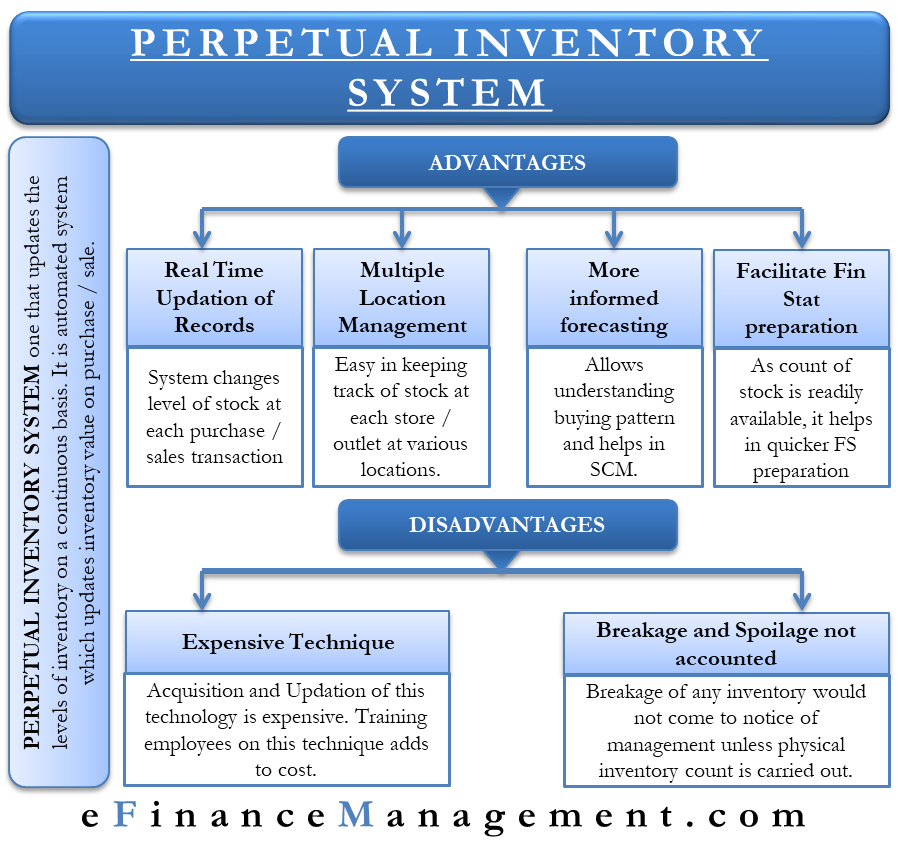To understand the advantages and disadvantages of the Perpetual Inventory System, think of an Ice-cream chain with 25 outlets across the city. Also, all the ice-creams sold in each of these outlets are prepared at a central facility located on the outskirts. Recently the chain has seen stock-outs because of a sudden rush of customers at some of the outlets. So, they are considering moving towards a perpetual system of inventory management.
A perpetual inventory system is one that updates the levels of inventory on a continuous basis. This system relies to a great extent on automation to instantly track purchases and sales and update the inventory records immediately. Hence, this system allows businesses to keep a real-time count of the inventory on hand.
Advantages of Perpetual Inventory System
Real-Time Updates
A perpetual inventory system records changes in stock levels in real-time as soon as the firm purchases inventory. And as soon as the firm sells some part of the inventory. So, this continuous stock tracking allows a firm to find out the inventory items that are running low at the right time.
So, if the Ice-cream chain finds that a particular flavor of ice cream is running low at some of the outlets, it can respond at the right time by preparing more quantity of that ice cream. And sending it to the outlets where it was running low before the inventory of that ice cream becomes zero, and the business loses its customers.
Managing Multiple Locations Easily
A perpetual inventory system allows a big company that operates at multiple locations to operate with ease. In the absence of a perpetual inventory system, it becomes difficult to track the inventory levels of all the stores/outlets at distinct locations. But, with a real-time inventory count of all the locations on your screen, it becomes very easy for the central facility to find out the total requirement of the chain and place an order for it.
More Informed Forecasting
A perpetual inventory system allows you to understand the buying patterns of customers. E.g., because the inventory system is constantly updated, the ice-cream chain may find out that a particular time of the day causes demand spikes or that a condition in weather is related to more demand for a particular flavor of ice cream. Hence, based on this knowledge, the business can then design its supply chain around the buying habits of its customers.

Facilitates Preparation of Financial Statements
The value of the inventory is a component of the financial statements. A perpetual inventory system avoids the delay in the preparation of financial statements as the count of the stock is readily available. So, this system avoids the long and costly process of physically counting the inventory levels.
Disadvantages of Perpetual Inventory System
Expensive Technique
Perpetual inventory systems are expensive. The technology necessary for the system (barcodes, scanner, computer software, etc.) to work can be a huge expense. Updating the existing system to accommodate the new one can also add to the expenses. Training the employees or adding new ones to work on the system is another expense. Hence, for a small firm with low margins, this system is not recommended.
Breakages and Spoilage Not Accounted For
The perpetual inventory system uses purchases and sales to update inventory levels. If some items break down or get spoiled after purchasing and storing them, they won’t come to the notice of the management unless a physical count is done. But, a physical count is not a part of the perpetual inventory system. So, until the ‘voluntary’ physical count happens, the management will count the broken parts as inventory. The same is the case with thefts. Hence, there is a possibility of error under this system.


am now interesting on the management